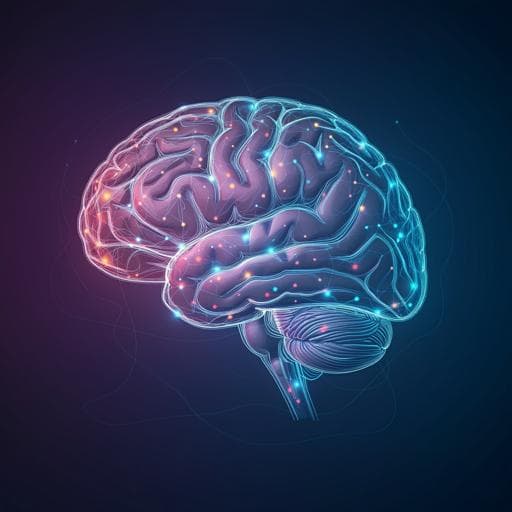
Medicine and Health
Interaction of neuropsychiatric symptoms with APOE ε4 and conversion to dementia in MCI patients in a Memory Clinic
S. Valero, M. Marquié, et al.
This study reveals how neuropsychiatric symptoms and APOE ε4 status can serve as predictors for dementia conversion in Mild Cognitive Impairment patients. Conducted by a team of experts including Sergi Valero and Marta Marquié, the research offers crucial insights for identifying those at elevated risk for dementia.
~3 min • Beginner • English
Introduction
Mild Cognitive Impairment (MCI) is an early stage of cognitive decline with preserved autonomy, often associated with neurodegenerative diseases, most commonly Alzheimer’s disease (AD). Because MCI represents an intermediate stage between normal cognition and dementia, identifying patients with higher risk of conversion is a priority. Interest has grown in the simultaneous influence of neuropsychiatric symptoms (NPS) and genetic factors on dementia risk, emphasizing potential gene–behavior interactions. Prior population-based studies have reported interactions between NPS and APOE ε4 in predicting incident dementia among cognitively healthy individuals or MCI patients; however, no study had evaluated this in a Memory Clinic cohort. The present study aimed to determine the effect of interactions between NPS and APOE ε4 on conversion to dementia in a large sample of Memory Clinic–diagnosed MCI patients, controlling for relevant clinical factors.
Literature Review
Previous literature indicates that NPS are prevalent in MCI and associated with increased risk of incident dementia, particularly AD. Meta-analytic work suggests limited consistent associations between APOE ε4 and NPS in MCI/AD, with anxiety showing some association to ε4 status. Two population-based studies examined NPS×APOE ε4 interactions: Burke et al. found additive interactions for multiple NPS with ε4 in predicting dementia among >11,000 cognitively intact participants; Pink et al. observed additive interactions for apathy and depression among 332 MCI participants. Multiplicative interactions are rarely significant; Burke et al. reported such for delusions and motor disturbances. The current work extends these findings to a Memory Clinic MCI cohort, assessing whether behavioral–genetic interactions predict conversion.
Methodology
Design and setting: Observational cohort study of MCI patients evaluated and followed in the Fundació ACE Memory Clinic (Barcelona, Spain) from 2005–2018. Ethics approval was obtained; informed consent provided.
Participants: Inclusion followed Petersen’s MCI criteria (subjective complaints, normal general cognition, preserved ADLs, absence of dementia, measurable cognitive impairment), CDR=0.5, age >60, literate, no severe sensory deficits. Standardized neurobehavioral exams and NBACE battery administered. Of 4173 MCI patients with ≥1 follow-up, 2030 had DNA samples; 1512 had baseline NPS data and were included. Included vs excluded were similar in age and sex; included had slightly lower MMSE (25.86 vs 26.1; p=0.002) and higher education (6.88 vs 6.37 years; p<0.001), both small effect sizes (d<0.13).
Neuropsychiatric symptoms: Assessed at baseline using the Spanish NPI-Q, covering 12 symptoms (agitation/aggression, delusions, hallucinations, depression/dysphoria, anxiety, euphoria/elation, apathy, disinhibition, irritability/lability, aberrant motor behavior, sleep/night behaviors, eating/appetite). Presence/absence was recorded based on caregiver report.
Neuropsychological assessment: NBACE battery assessing 8 domains: orientation; attention/working memory (WAIS-III digit spans); processing speed/executive function (SKT inhibition, phonemic and semantic fluency, WAIS-III similarities); language (repetition, comprehension from ADAS/Barcelona battery, 15-item Boston Naming); verbal learning/memory (WMS-III word list learning); praxis (WAIS-III block design abbreviated, imitation, ideomotor praxis); visual gnosis (Poppelreuter, Luria clock, 15-objects test); and global cognition (Spanish clock test).
APOE genotyping: Genomic DNA from blood; APOE genotypes via TaqMan assays for rs7412 (C_904973_10) and rs429358 (C_3084793_20) on QuantStudio3. PCR conditions per manufacturer. Genotypes called using Thermo Fisher Cloud Genotyping App. Lab personnel were blinded.
Outcomes: Conversion to dementia during follow-up (CDR=1), including AD, vascular dementia, mixed (AD+cerebrovascular), frontotemporal dementia, and dementia with Lewy bodies. Non-converters remained MCI.
Clinical classification: MCI subtype (amnestic vs non-amnestic). Primary etiological attribution recorded as degenerative, vascular, psychiatric, or other.
Personal/family history and comorbidities: Family history of neurological/psychiatric conditions (dementia, Huntington’s, Parkinson’s, psychiatric disorders, Down syndrome) coded present/absent and summarized via factor analysis into a single standardized component (FamMedHist_comp). Twelve medical comorbidities (hypertension, dyslipidemia, diabetes, cardiopathy, stroke, traumatic brain injury, epilepsy, depression, COPD, kidney disease, thyroid disease, osteoarthritis) summarized via factor analysis into MedComorb_comp.
Medications: Antidepressant and anxiolytic prescriptions recorded (ever vs never during follow-up).
Statistical analysis: Associations between NPS and conversion assessed by chi-square. Time-to-conversion analyzed with Cox proportional hazards models, estimating HRs and 95% CIs for NPS, APOE ε4 status, and their interactions. Both additive and multiplicative interaction scales were examined per STROBE guidance, coding interactions per Andersson et al. Models were run unadjusted and adjusted for age, sex, education, baseline MMSE, MCI subtype (amnestic vs non-amnestic), FamMedHist_comp, MedComorb_comp, etiology (degenerative as reference, others as dummies), and antidepressant/anxiolytic use. For descriptive estimates, bootstrapped 95% CIs (k=500) were computed. Two-tailed p<0.05 considered significant. Analyses in STATA 15.
Key Findings
- Sample characteristics: 1512 MCI patients; mean follow-up 2.03 years (SD 1.68; median 1.38). APOE ε4 carriers (heterozygous/homozygous): 31%. Amnestic MCI: 67.9%. Etiology: 31.6% degenerative, 26.7% vascular, 33.5% psychiatric, 8.2% other. Antidepressant use 31.2%; anxiolytic 20%. Conversion to dementia: 58.2%.
- Baseline NPS prevalence ranged from ~55% (depression, anxiety) to <0.5% (elation/euphoria, motor disturbances). Elation/euphoria and motor disturbances were excluded from inferential analyses due to low numbers.
- Distribution of NPS by APOE ε4: Only anxiety differed, being less prevalent among ε4 carriers than non-carriers (χ2 p=0.002). Other NPS showed no significant association with ε4 status.
- Converters vs non-converters: Converters were older, more often female, had fewer years of education, more often APOE ε4 carriers, lower MMSE, and were more often amnestic MCI (all p≤0.008). Degenerative etiology was more prevalent among converters (37.7% vs 22.9%). Among NPS, baseline apathy, agitation/aggression, appetite/eating, and disinhibition were associated with higher conversion (night behaviors were more prevalent in non-converters).
- Cox models (adjusted results unless noted):
• APOE ε4 main effect: HR 1.39 (95% CI 1.13–1.72), p=0.002.
• Depression/dysphoria main effect: HR 1.09 (0.92–1.29), ns; additive interaction with ε4: HR 1.58 (1.29–1.94), p<0.001; multiplicative interaction not significant.
• Apathy main effect: HR 1.42 (1.19–1.69), p<0.001; additive interaction with ε4: HR 1.71 (1.39–2.09), p<0.001; multiplicative interaction significant and inverse: HR 0.74 (0.55–0.98), p=0.038.
• Anxiety main effect: HR 1.01 (0.85–1.20), ns; additive interaction with ε4: HR 1.45 (1.19–1.76), p<0.001; multiplicative interaction not significant.
• Agitation/aggression main effect: HR 1.51 (1.01–2.26), p=0.043; additive interaction with ε4: HR 1.85 (1.07–3.19), p=0.027; multiplicative interaction not significant.
• Night behaviors main effect: HR 0.81 (0.67–0.98), p=0.032 (protective); additive interaction not significant after adjustment.
• Appetite/eating main effect: HR 1.18 (0.87–1.57), ns; additive interaction with ε4: HR 2.03 (1.41–2.93), p<0.001; multiplicative interaction not significant.
• Irritability/lability main effect: HR 0.94 (0.79–1.12), ns; additive interaction with ε4: HR 1.30 (1.05–1.62), p=0.015; multiplicative interaction not significant.
• Disinhibition, delusions, hallucinations: main effects and interactions largely not significant after adjustment.
- Incremental risk on additive scale: Interactions indicated 30% to >100% increased risk vs ε4−/NPS− reference; average ~60%. Appetite/eating and agitation/aggression with ε4 showed the highest incremental risk (>85%).
- Dementia subtypes among converters: 74% AD, 12% vascular dementia, 4.3% frontotemporal dementia; remainder other dementias. In logistic regression differentiating AD vs other dementias (adjusted), apathy was the only NPS associated with non-AD conversion (Wald=4.20, p=0.041; 95% CI 1.01–1.96).
Discussion
Findings demonstrate that in MCI patients followed in a Memory Clinic, NPS and APOE ε4 independently and synergistically predict conversion to dementia when considered on an additive interaction scale. Despite minimal association between ε4 status and most NPS (with the exception of anxiety), the co-occurrence of certain NPS (depression, apathy, anxiety, agitation/aggression, appetite/eating changes, irritability) with ε4 status substantially elevates conversion risk beyond the sum of individual effects. Additive interaction emerged as the more informative scale, aligning with epidemiologic recommendations for biologic interaction assessment. Notably, agitation/aggression and appetite/eating changes were particularly discriminative only when combined with ε4, underscoring a clinically relevant gene–behavior synergy that is not apparent from main effects alone. Adjusted analyses showed these interactions were robust to demographic, cognitive, etiologic, comorbidity, family history, and medication covariates, suggesting limited confounding by these factors. The rarity of significant multiplicative interactions is consistent with prior literature; the sole significant multiplicative finding (apathy) indicated a sub-multiplicative effect despite clear additive synergy. Clinically, integrating behavioral assessments with APOE genotyping may enhance risk stratification to identify MCI patients at highest risk for near-term progression to dementia.
Conclusion
In a Memory Clinic cohort of MCI patients, additive interactions between APOE ε4 and several neuropsychiatric symptoms (depression, apathy, anxiety, agitation, appetite/eating changes, irritability) significantly predict conversion to dementia, while most individual main effects are weaker. Behavioral and genetic risk factors are largely independent, but their convergence yields the most discriminative prognostic signal. These findings support combined behavioral–genetic risk profiling in clinical settings to identify vulnerable MCI patients. Although APOE status is not modifiable, NPS may be targetable through pharmacologic and non-pharmacologic interventions, potentially improving outcomes. Future research should include longer follow-up periods, adequately powered analyses of low-prevalence NPS, and exploration of biological mechanisms underlying these interactions, as well as validation across diverse clinical populations.
Limitations
- Follow-up duration was relatively short (mean ~2 years), limiting assessment of longer-term conversion dynamics and stability of interaction estimates.
- Low-prevalence NPS (elation/euphoria, motor disturbances) were excluded, potentially missing interactions for rare symptoms; clinical referral patterns may further reduce their observation in this setting.
- APOE ε4 primarily confers AD risk, while conversion outcomes included all dementias; although most converters had AD (~74%), this may introduce some imprecision in gene–behavior interaction estimates across mixed dementia etiologies.
Related Publications
Explore these studies to deepen your understanding of the subject.







